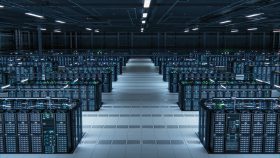Amazon Extends AWS to IoT Edge

While Amazon Web Services (AWS) is closely identified with all things relating to the public cloud, it turns out the Internet of Things (IoT) applications are becoming a more strategic imperative for the world's largest cloud service provider.
At the AWS re:Invent 2017 conference on Wednesday, AWS expanded its IoT portfolio to include six additional offerings to complement the AWS Greengrass platform that AWS rolled out last year to extend the reach of the AWS Lamba serverless computing framework to IoT environments.
The new additions include:
- AWS IoT 1-Click: Provides a simplified instance of the code required to connect an IoT device to AWS Lambda serverless cloud infrastructure. Devices running AWS IoT 1-Click can download Lambda code and be updated much like a mobile phone application.
- AWS IoT Device Management: Enables IT organizations to centrally manage a fleet of IoT devices. Previously, AWS enabled only the management of one IoT device sequentially.
- AWS IoT Device Defender: Due out sometime in the first half of 2018, AWS with continually audit where IoT devices comply with an organization's security policies.
- AWS IoT Analytics: Available in a preview mode, this managed service offloads all the management of an IoT analytics application to AWS.
- Amazon FreeRTOS: an operating system specifically designed to be deployed on low-power endpoints such as lightbulbs or smoke detectors.
- AWS Greengrass ML Inference: An extension to the AWS Greengrass that enables models developed using machine learning algorithms to be deployed locally.
- AWS CEO Andy Jassy told conference attendees that IoT is now a major area of focus for AWS.
"We're now entering a world where the growth number of devices is going to be exponential," said AWS CEO Andy Jassy.
Today at the conference, Amazon CTO Werner Vogels made a case for the need for data-driven IT architecture that will drive real-time applications incorporating different classes of IoT devices, many of which will increasingly be accessed using voice interfaces. Via those interfaces end users will interact with artificial intelligence (AI) applications based on neural networks that will execute action on their behalf. The intelligence with driving those applications will reside in the cloud, says Vogels.
In many cases, Vogels says those voice interfaces will eliminate the need for dedicated applications at a time when many end users are starting to suffer from application fatigue. For example, AWS today announced Alexa for Business, an instance of its voice-activated cloud service that is integrated with multiple third-party conference systems.
Vogels says these types of applications will require a massive transformation in terms of how backend services are delivered using serverless and other high-performance computing (HPC) services delivered by AWS.
The irony, of course, is that AWS as a proponent of cloud computing has long contended that applications should be centrally deployed in datacenters managed by AWS. Greengrass extends a proprietary serverless computing framework to an IoT edge. The framework will run applications developed using a proprietary programming language that is not yet well understood by most developers.
That doesn't mean that AWS won't enjoy considerable IoT success. But it doesn't necessarily follow that the current dominance AWS enjoys in the public cloud today will guarantee success in IoT environments that tend to value more open approaches to computing.

















